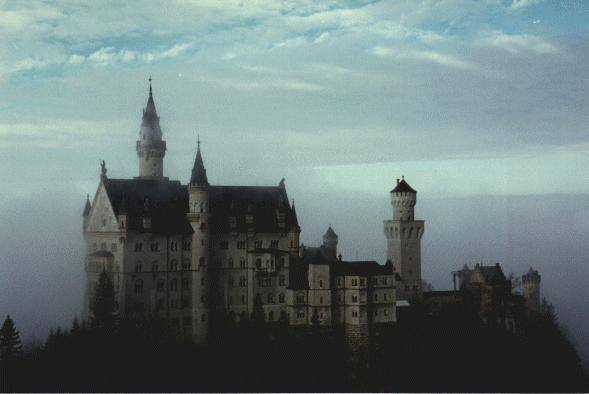
[ Note: The following article was written in 1995. Information
about prices, times, etc. have changed. To get up-to-date information
about visiting Neuschwanstein and Hohenschwangau, visit Neuschwanstein
]
Each year for the past five years my wife and I have taken high school students to Germany and Austria during school holidays. Following each of the trips we have the students complete surveys about what they have seen in order to help us plan for the next year. In each case the selection for "Most Outstanding Manmade Structure" has been the grandest of Mad Ludwig II's castle-building projects, Neuschwanstein. Perched precariously on a crag high above the Pollat Gorge near the village of Hohenschwangau only a few miles from Fuessen, the castle (thanks to the copy in Fantasyland) is one of the most easily identified structures in Europe for North American travelers. Its familiar walls and towers leap out at us from the covers of travel guides and magazines, posters outline its tiniest details from many angles, and jigsaw puzzle manufacturers allow us to emulate the original builders reconstructing it seemingly stone-by-stone. During our visits to the castle in the past, we have seen it on days of bright sunshine, when the brilliance of the white walls seen from a distance make it clear that this is what Ludwig must have envisioned in those happy days when he planned it only a little more than 100 years ago. On visits during colder seasons, the white of the walls is indistinguishable from the white of the snow covering the roofs and trees, transforming Neuschwanstein into a winter dreamscape where with just a little imagination we might see the face of Ludwig in one of the windows peering down from the icy heights, more isolated than ever from his subjects below. When we see the castle on gloomy, overcast days when the white walls turn to gray, we think more of the sad end to Ludwig's life, removed from the throne for his extravagance with Neuschwanstein still unfinished. A few days later his body was found floating in Lake Sternberg; the mystery of his death (murder or suicide?) has never been solved.
In planning for our most recent trip to the castle, we debated which of perspectives we might prefer. We were truly disappointed when we arrived in Hohenschwangau to find the entire village covered by a thick fog. We reconciled ourselves to the fact that weather can always alter an itinerary, knowing also that interior of the castle would provide a memorable visit for the students. They could see the Byzantine throne room with its domed "sky" and massive chandelier; they could better understand the "schwan" portion of the castle's name when they found samples of the Lohengrin swan motif scattered throughout the living quarters; the massive minstrel hall would remind them of what royal privilege could mean; and the castle kitchen could illustrate the technical advances of the late 19th century.
As an afterthough, we decided that it might be fun to take the minibus up from the village and walk across the Marienbrucke in the fog. This suspension bridge hangs 300 feet above the Pollat Gorge and on clear days provides a magnificent viewing point from which to see the castle and much of the valley in the distance below.

Soon after we arrived, we were able to get brief glimpses of some of the towers as the fog rolled around us. Then, suddenly, as if on cue, the top of the fog layer dropped by a few meters and the entire castle suddenly appeared, seeming to be magically supported by the whirling clouds about its base. For the few minutes that the fog cooperated, the castle became transformed into a part of the set for the Wagnerian operas illustrated on its inside walls. Once again, Neuschwanstein had been truly "neu" for us; we can only wonder what can be in store for our next visit.
For the day visitor, Neuschwanstein is only a short drive from Munich, and there is plenty of parking in the village below. Panorama Tours in Munich also offers a day trip to the Royal Castles for about 65-70 DM. A do-it-yourself daytripper can take the train to Fuessen and a bus or taxi out to the village. Try to arrive as early in the day as possible. The crowds can be huge and the lines very long.
The best way to visit the castle is to spend the night in the town itself. Then, you can take a leisurely walk around the Alpsee; you'll have time to add a trip to Hohenschwangau Castle, Ludwig's boyhood home; and you'll have the pleasure of seeing both castles illuminated at night. The best-known hotels in the village are the Lisl and the Mueller, and very near the castle itself, the Schloss Restaurant rents a few rooms. However, our favorite spot for an overnight stay is the Pension Weiher at Hofwiesenweg 11 (telephone 8362 81161). In what may be the best value in all of Bavaria, Frau Oswald rents five or six comfortable wood-paneled rooms (several with a balcony view) and includes a huge breakfast for a price that's about a half to a third of what comparable rooms cost throughout the region.
Remember, whenever you visit Neuschwanstein, be prepared to walk
and stand in line. Even if one takes the horse drawn carriage up to the
Schloss Restaurant or the minibus up to the Marienbrucke (both about 3 DM),
there's still a walk of about one-fourth mile to the castle itself. The traveler
who opts to walk from the village itself faces about 30-40 minutes uphill.
Even with these inconveniences, the castle is worth the trouble (as the
huge crowds attest). Little could the Bavarian people imagine 110 years
ago when they worried about Ludwig bankrupting the treasury how much money
his project could generate from the tourists coming from around the world
to see a little part of his dream.